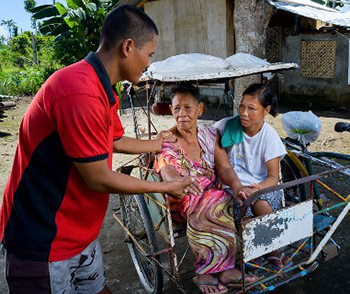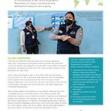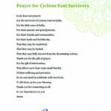
Typhoon Haiyan, One Year Later
Even the richest country in the world has trouble recovering from a major natural disaster, as Hurricanes Katrina and Sandy demonstrated. So it's no surprise that the same story is playing out in the Philippines after Super Typhoon Haiyan, which hit on November 8, 2013. It was the strongest recorded storm to ever make landfall on this nation of islands.

"CRS has been working hard to help rebuild communities after Haiyan, but it's only with leaders like Ric that residents can find hope, purpose and resolve to rebuild their lives better than before," says Catholic Relief Services program manager Anna Hrybyk.
"When the wind quieted, I looked outside," Ric says of the night of Haiyan, which he spent in an elementary school evacuation center, away from his family. "I saw no more houses, no more grass. I didn't know what to do, where to start, not only for my own family, but for all of my neighbors too."
CRS provides a lifeline
Ric, 30, had just been elected chairman of his "barangay," or community, when Haiyan hit. That's why he stayed in the elementary school the night of Haiyan: He didn't want to leave his constituents, even though his family was in a different evacuation center.
"Everyone in the shelter was so afraid, I couldn't leave them," he says.
The sitting barangay chairperson had gone to Manila. So although Ric had not formally taken office, he found himself in charge of a community that seemed rudderless while facing the most difficult challenge in its history.
"My first thought was to find food. I walked to Palo looking for help, then all the way to Tacloban," which is more than 3 hours one way, he says. "I found food that would have been enough for my own family, but I had nearly 100 families to feed. I knew that to feed everyone, we had to clear the road. And so we did. Three days after the storm, everyone took the tools they had found and began clearing debris and downed trees by hand. The next day, relief food finally reached us."
Next, Ric sought emergency shelter from CRS. The tin and palm fronds families had salvaged and cobbled together for roofs were no match for heavy tropical rains. CRS provided tarps and long-term help in building new homes.
Eighty-seven families needed such shelters. Even though he could have easily taken the first home for himself and his family, who were living in a makeshift lean-to, Ric told CRS that his home would be built after his neighbors'.
"I wanted to make sure my neighbors got the best houses in the fastest possible time," he says. "It didn't matter if people voted for me or not. We all needed safe and dry places to sleep."
Local leadership key to recovery
Ric and his wife Evelyn moved into their new home in July. It was, indeed, the last to be completed in Cabarasan Guti. Ric plans to add an indoor kitchen as soon as he can save enough from his bicycle rickshaw business to buy materials.
"After Haiyan, there were times I couldn't see my own family," he says. "It took all of my time to get goods and food for the whole community. I would walk to Palo every day looking for help. I give all credit to my wife for the success of our barangay. She is the one who helped my sons forget their fear of the storm by playing with them, telling them stories, coloring and talking with them. I knew I could focus on getting help for everyone, because she took care of getting help for our boys. I'm so thankful to CRS and my neighbors, but I am most thankful for her."
"And CRS is most thankful for Ric's leadership, which was a big reason why we chose to build our first shelters after the storm in Cabarasan Guti," says Hrybyk.




